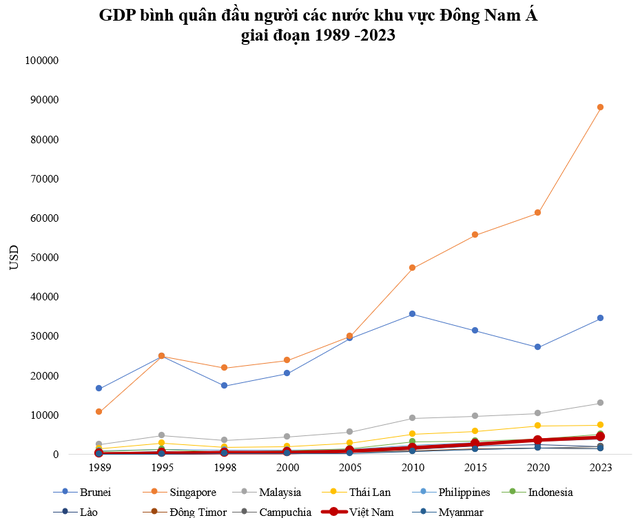According to the data from the International Monetary Fund (IMF), in 1989, Vietnam’s per capita GDP was lower than that of Laos (353.3 USD) and the Philippines (800 USD). Vietnam’s per capita GDP was only about 1/3 of Laos and 1/6 of the Philippines.
In the period from 1989 to 1997, Vietnam’s per capita GDP continued to be lower than that of Laos and the Philippines. However, in 1998, Vietnam’s per capita GDP surpassed Laos. In 1998, Vietnam’s per capita GDP reached approximately 448.12 USD, while Laos reached about 446 USD. Thus, Vietnam’s per capita GDP officially surpassed Laos after 9 years of being only about 1/3.
By 2020, Vietnam’s per capita GDP had also surpassed the Philippines. In 2020, Vietnam’s per capita GDP reached about 3,549 USD, while Laos reached about 2,530 USD and the Philippines reached about 3,326 USD. Thus, Vietnam’s per capita GDP officially surpassed the Philippines after 31 years of being about 1/6.
From 2020 to the present, Vietnam’s per capita GDP has consistently been higher than that of Laos and the Philippines.

Per capita GDP of Southeast Asian countries from 1989 to 2023. Source: IMF.
When considering all the countries in Southeast Asia, Vietnam’s per capita GDP has undergone significant changes from 1989 to 2023.
In 2023, Vietnam’s per capita GDP ranked 6th out of 11 in Southeast Asia. Singapore, Brunei, Malaysia, Thailand, and Indonesia still have higher per capita GDP than Vietnam. The per capita GDP of Singapore, Brunei, Malaysia, Thailand, and Indonesia are currently 20 times, 8 times, 3 times, 1.7 times, and 1.2 times higher than Vietnam’s per capita GDP, respectively.
After 34 years of development efforts, Vietnam’s per capita GDP has increased from 123.36 USD in 1989 to 4,316 USD in 2023.
In the period from 1989 to 2023, Vietnam’s per capita GDP has experienced the highest growth rate among Southeast Asian countries (35 times). Other countries have also made improvements but at a slower pace, such as Myanmar (33 times), Cambodia (13 times), East Timor (12 times), Singapore (8.2 times), Indonesia (7.3 times), Malaysia (5.5 times), Thailand (5.4 times), Laos (5.31 times), the Philippines (4.7 times), and Brunei (2.1 times).
According to the Resolution of the Central Committee, by 2030, Vietnam aims to achieve the criteria of an industrialized country, including being a developing country with a modern industry and a high average income.
According to the Resolution, the Government sets the goal and strives to achieve the objectives, targets, and key tasks of the National Master Plan by 2030. Specifically, in terms of the economy, the Government aims for an average annual GDP growth rate of about 7.0% for the period 2021-2030.
By 2030, the per capita GDP based on current prices is expected to reach about 7,500 USD. The proportion of the service sector in GDP is expected to be over 50%, the industrial and construction sector over 40%, and the agriculture, forestry, and fisheries sector below 10%.
The average annual growth rate of labor productivity is expected to exceed 6.5%. The contribution of total factor productivity (TFP) to growth is expected to be over 50%.
Developing sustainable urban areas according to the network; the urbanization rate is expected to exceed 50%; striving for 3-5 cities at the regional and international level. Building comprehensively developed, sustainable new rural areas closely linked to urbanization; the proportion of communes meeting the standard of new rural areas is expected to exceed 90%, with 50% of communes meeting the standard of advanced new rural areas.
Developing strong digital infrastructure, data infrastructure as a foundation for national digital transformation, developing digital government, digital economy, and digital society; the proportion of the digital economy is expected to reach about 30% of GDP.
In terms of developing infrastructure, establishing a basic framework for national infrastructure, including important North-South road traffic axes (the Eastern North-South expressway, some sections of the Western North-South expressway, coastal roads), important East-West traffic axes, and striving for about 5,000 km of expressways.









































